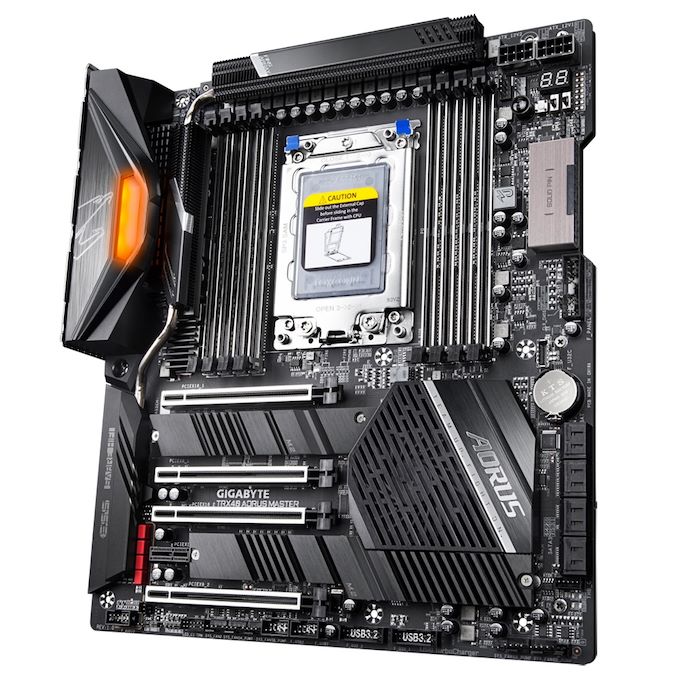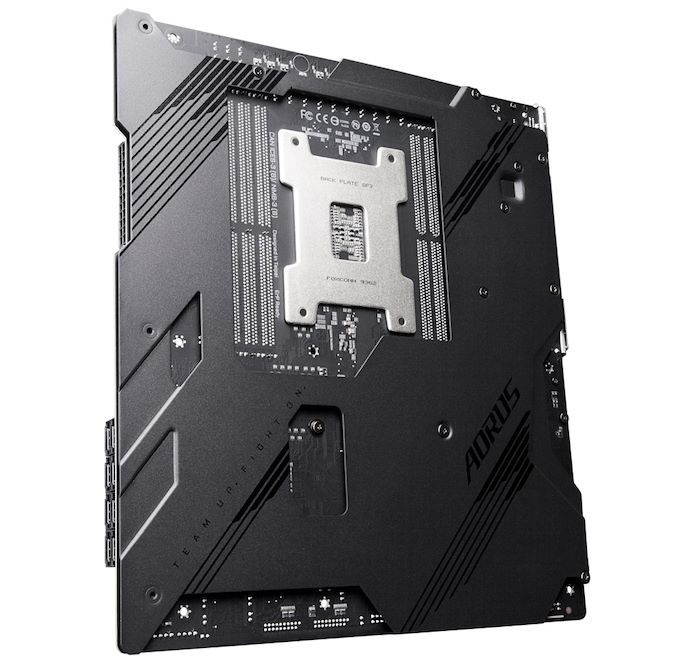The AMD TRX40 Motherboard Overview: 12 New Motherboards Analyzed
by Gavin Bonshor on November 28, 2019 9:00 AM EST- Posted in
- Motherboards
- AMD
- MSI
- Gigabyte
- ASRock
- Asus
- TRX40
- Threadripper 3000
- Castle Peak
GIGABYTE TRX40 Aorus Master
The GIGABYTE TRX40 Aorus Master sits below the TRX40 Aorus Xtreme in the product stack and combines a similar style, in a slightly smaller, but still larger than normal E-ATX PCB. Still retaining the high-end feel, the TRX40 Master is using an E-ATX PCB which is crammed with good quality controllers. The most notable features include support for DDR4-4400 and 256 GB, a pair of Ethernet ports on the rear panel including an Aquantia 5 G controller, Intel's AX200 Wi-Fi 6 wireless interface, and a beefy 16-phase CPU power delivery.
Starting from the top, the GIGABYTE TRX40 Aorus Master has eight memory slots in two banks of four on either side of the sTRX4 socket with support for DDR4-4400 and up to 256 GB in total. Taking a slightly more basic approach to the aesthetics, the rear panel cover does include integrated RGB LEDs, with black heatsinks on a black PCB. The large black aluminium power delivery heatsinks which are interconnected via a heat pipe are cooling a 16-phase power which consists of an Infineon XDPE132G5C 16-phase PWM controller, with sixteen Infineon TDA21472 70 A power stages. Providing power to the CPU is two 8-pin 12 V ATX power connectors which are located in the top right-hand corner.
Also at the top right-hand corner of the board is a two-digit LED debug, while below this is a right-angled 24-pin motherboard power connector. For PCIe devices, there are four full-length PCIe 4.0 slots which operate at x16/x8/x16+x8 and a single PCIe 4.0 x1 slot. The TRX40 chipset heatsink is actively cooled just as we saw with X570. For storage, the GIGABYTE TRX40 Aorus Master has three PCIe 4.0 x4 M.2 slots which include M.2 heatsinks for each slot, and there are eight SATA ports with support for RAID 0, 1, and 10 arrays.
Like with the GIGABYTE TRX40 Aorus Xtreme, the TRX40 Aorus Master also includes a large black metal backplate which will add extra weight to the board. The backplate displays the motto 'Team Up, Fight On' which is more of a gaming term, which is understandable given the boards Aorus branding. The TRX40 Aorus Master includes dual BIOS with a switch which allows users to select between the two, and for cooling, there is a total of eight 4-pin headers. These are split into one for a CPU fan, one dedicated for a water pump, and six for chassis fans.
On the rear panel are five USB 3.1 G2 Type-A, one USB 3.1 G2 Type-C, and two USB 2.0 ports. There are two Ethernet ports with one controlled by an Aquantia 5 G, and the other by an Intel Gigabit Ethernet controller. This model also includes Intel's AX200 Wi-Fi 6 wireless interface and also adds BT 5.0 connectivity too. To the left-hand side is a Clear CMOS and Q-Flash Plus switch, with the five 3.5 mm audio jacks and S/PDIF optical output handled by a Realtek ALC4050H and Realtek ALC1220 audio codec pairing. The TRX40 Aorus Master also includes a Realtek ALC4050H and ESS Sabre 9218 DAC for the front panel audio.
The GIGABYTE TRX40 Aorus Master is still a high-end TRX40 motherboard and with an MSRP of $499, it isn't exactly cheap, but it does offer users plenty of good quality features on AMD's new HEDT platform. While the Aorus brand is mainly targeted at gamers, the TRX40 Aorus Master looks to combine elements from both the enthusiast and gaming sides, to create a reasonably priced multi-purpose model for all looking to use and unlock all of the power within the Threadripper 3000 processors.













109 Comments
View All Comments
The_Assimilator - Thursday, November 28, 2019 - link
Making a CPU that fits in a socket but doesn't work in it is idiotic. Especially considering the target market, did AMD really need to save a few pennies on getting Lotes to make slight modifications to their TR3 tooling?Spunjji - Friday, November 29, 2019 - link
"Especially considering their target market"System integrators, enthusiasts and experts?
yetanotherhuman - Friday, November 29, 2019 - link
All of them have fans. Bleh. I remember chipset fans. No thanks. X570 is a piece of shit to me for the same reason (apart from that one gigabyte board that costs way too much).jeremyshaw - Friday, November 29, 2019 - link
Also one Asrock board which costs even more!Korguz - Friday, November 29, 2019 - link
all be cause of a chipset fan ?? thats borderline crazy, have you even heard them ? chances are, the other fans in your case would drown it out and you wouldnt even hear ityetanotherhuman - Friday, November 29, 2019 - link
They fail, they're usually a weird size or fitment, and they whine.. case fans are usually much larger and have a far different (and much more pleasant) toneKorguz - Friday, November 29, 2019 - link
i have an Athlon 64 board, with a fan on the chipset, still works just fine, no issues.. nothing.. so those who are wining about these, are unfounded.Larch - Friday, November 29, 2019 - link
Yeah they do fail sometimes (or used to anyway), and it kinda silly that they they nowadays have these weird shapes because of aesthetics making them hard to replace. Not everyone use windowed cases.With that said it shouldn't be a big problem to strap a casefan on in case of failure.
I have the X570 with chipset fan and do wish they would have solved it with a beefier heatsink instead. Seems like a cost issue (in fact I think there is at least one X570 board w/o chipset fan)
eek2121 - Friday, November 29, 2019 - link
It's not how 'beefy' a chipset is, but rather, the size of it. PCIE 4.0 is pushing the chipset, on the current node, to it's limits. A die shrink might fix this, or it might actually make the problem worse.eek2121 - Friday, November 29, 2019 - link
Chances are IF they fail, they are under warranty. If not, you can replace them. However, I've had (non-chipset) fans last for decades. I still have a fan from an old 386 system that works just fine and dandy.